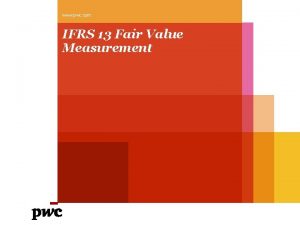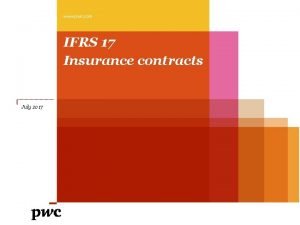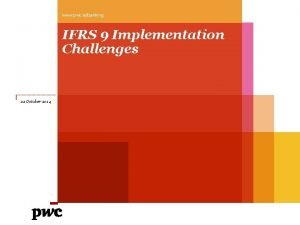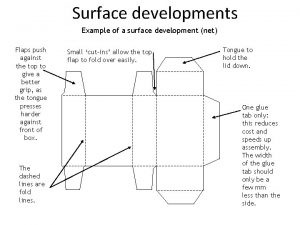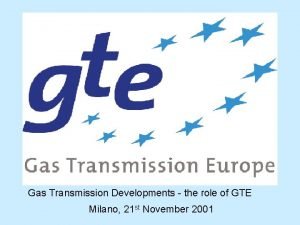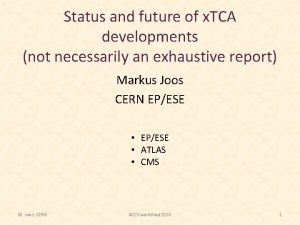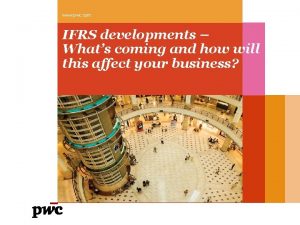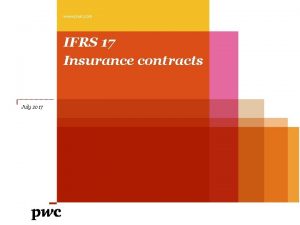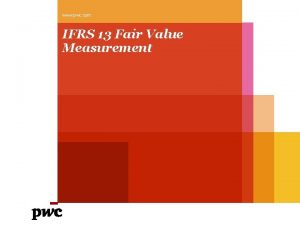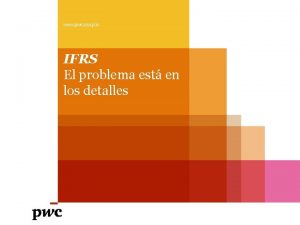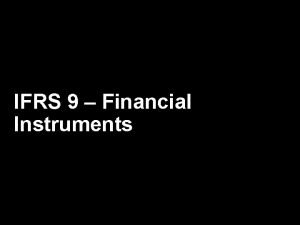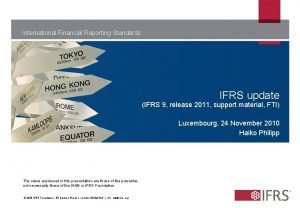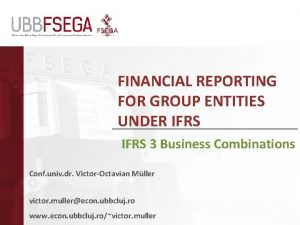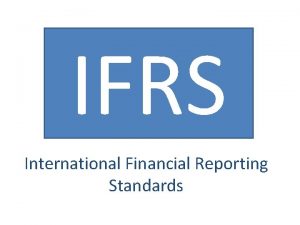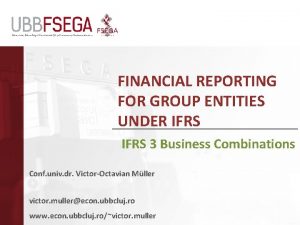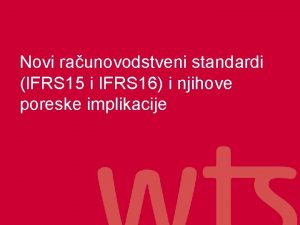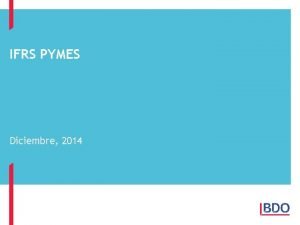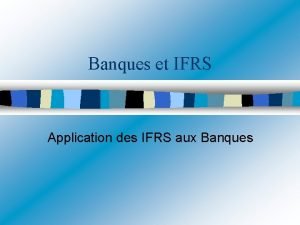www pwc com IFRS developments Whats coming and





















- Slides: 21

www. pwc. com IFRS developments – What’s coming and how will this affect your business?

IASB’s work plan Financial Instruments – Macro hedging Rate-regulated Activities Conceptual Framework Disclosure Initiative Others Pw. C 2

New accounting developments IFRS 17 Insurance contracts Pw. C New Requirements Impact • Final standard issued on 18 May 2017, which will come into effect on 1 January 2021 • Scope: all insurance contracts issued by any entity and investment contracts with discretionary participating features issued by insurers • Current measurement model: estimates re-measured each reporting period • Use of OCI for difference between discounted cash flows using current market rates and the discount rates on an appropriate cost basis; this is now optional rather than mandatory • Changes in cash flow and risk adjustment related to future coverage and other services to be recognised against contractual service margin • A variable fee approach (VFA) will be used for direct participating contracts whereas indirect participating contracts will apply the building block approach (BBA) for non-participating contracts. A premium allocation approach (PPA) is to be used for non-complex contracts with coverage periods of no more than 12 months. • Presentation of insurance contract revenue and expenses aligns with other industries, and premium information is prohibited in the p/l • Transition: full retrospective application for insurance contracts in force at transition unless it is impractical, in which case may use the simplified retrospective approach or the fair value approach. • IASB published the amendment to IFRS 4 in September 2016 that introduces the overlay and deferral approaches to address concerns over different effective dates for IFRS 9 and IFRS 17. An insurer should test its eligibility to defer IFRS 9 as at its annual reporting date that immediately precedes 1 April 2016. • On 14 November 2018, the IASB Board tentatively decided to defer the mandatory effective date of IFRS 17 by one year, so that entities will be required to apply IFRS 17 for annual periods beginning on or after the 1 January 2022. • On 13 December 2018, the IASB Board tentatively decided to amend the requirements in IFRS 17 so that the presentation of insurance contract assets and liabilities in the statement of financial position is determined using portfolios of insurance contracts rather than groups of insurance contracts, and tentatively decided not to amend the requirement in IFRS 17 for 11 topics. • Reduces income statement volatility to some extent • Adds significant complexity and creates extra demands on resources, data and modelling systems 3

New accounting developments IFRS 16 Leases Pw. C New Requirements Impact Final standard issued on 13 January 2016 , which will come into effect on 1 January 2019. • Change in definition of lease • Updated guidance on modification, combination & separation of contracts, sub-lease, sales and lease back, segregation of lease and non-lease component • Lessee accounting - significant change: • all leases will be on-balance sheet unless they are short-term or small ticket leases (Right-of-Use asset and a liability to make lease payments) • a single income statement approach that result in front loaded expenses for all leases. • Lessor accounting: • the accounting stays almost the same; the updated guidance mentioned above will affect lessor as well. • at the very least, the new accounting model for lessees is expected to impact negotiations between lessors and lessees. • More requirements on quantitative and qualitative disclosures • Transition : • earlier application is permitted, but only in conjunction with IFRS 15, ‘Revenue from Contracts with Customers’ • full retrospective application Vs simplified approach • reassess whether a contract is, or contains, a lease at the date of initial application is not required (i. e. "grandfathered”). • At its May 2018 meeting, the IASB has tentatively decided to amend Illustrative Example 13 in IFRS 16 by an annual improvements, by removing the reimbursement of leasehold improvements by the lessor. • Structuring of certain transactions; • Lease vs. buy decisions • Typical negotiated terms may change • Tax accounting impact • Compliance of bank covenant • Budget and staff compensation KPI may also change • Information gathering, system , process and control needs to be revisited and updated • Regulatory capital impact • Analysis by Financial Statement users and investor relationship • This removes an apparent ambiguity and contradiction between the IE and the standard 4

New accounting developments IFRS 15 Revenue from Contracts with Customers Pw. C New Requirements Impact • Final standard issued on 28 May 2014; requires a 5 -step approach: 1. Identify contract – New definitions and additional guidance on contract combination and modification; 2. Separate performance obligation – Performance obligation is accounted for separately if it is “distinct”; a good/service is distinct if the customer can benefit from the good/service on its own and it is separately identifiable from other promised goods/services in the contract; 3. Determine transaction price – Variable consideration based on probability weighted or most likely amount which is then constrained up to the amount that is probable of no significant reversal in the future; reflect time value when significant; credit risk as an expense in separate line on face and measured based on IFRS 9; 4. Allocate transaction price – Based on relative selling price; “residual approach“ only used when there is performance obligation in a contract with standalone price which is highly variable or uncertain; 5. Recognise revenue – Model now based on control, but risk and rewards remains an indicator; criteria for satisfied over time introduced. • Other guidance included for capitalisation of contract costs and license arrangements • This guidance also apply to transfers of non-financial assets that are not an output of an entity's ordinary activities • Disclosures are required on disaggregation of revenue (both for interim/final reporting), contract balances, remaining performance obligations, etc. • Effective for annual reporting periods beginning on or after 1 January 2018, apply retrospectively with certain practical expedients available or through cumulative adjustment at date of application of new standard. Early adoption is permitted • In April 2016, IASB amended IFRS 15 to clarify three areas: the principal versus agent assessment, identifying distinct performance obligation and licences. The amendment also provided more additional practical expedients guidance for transition. • The amendments to IFRS 15 are not, in all instances, the same as those the FASB is making to the US standard (ASC 606). The IASB has generally indicated in the Basis for Conclusions where it expects that the differences in wording between the standards will or could result in different conclusions under IFRS and US GAAP. Overall speaking, the standard is still a converged one in most aspect. • Reassessment of contracts will be time consuming • System, process and internal control implications • Increased use of estimates (contingent fees, time value, etc. ) • Tax implications • Training and education for finance, sales & investor relations • Full retrospective application may require running dual system & gathering of historic data • Performance measures may be affected 5

New accounting developments New Requirements IFRS 9 – Financial instruments (issued) Classification and measurement • Financial assets: Reduced from six to three categories – one at amortised cost and two at fair value; no bifurcation of embedded derivatives • Equity instruments always measured at fair value. If held for trading - FVPL, otherwise can irrevocably elect FVOCI • Debt instruments may be measured at amortised cost, if meet both “Held to collect contractual cash flow” and “cash flows represent solely principal and interest” (SPPI) • Some simple debt instruments may be measured at FVOCI, if held within a business model whose objective is achieved by both collecting contractual cash flows (that meet the SPPI requirement) and selling financial assets • Other debt instruments are measured at FVPL • Certain prepayable financial assets with so-called negative compensation may pass the SPPI test and may be measured at amortised cost or at FVOCI (depending on the business model). This amendment is effective from 1 January 2019 but early adoption is permitted. • Financial liabilities: • Fair value changes on own credit risk taken to OCI (for fair value option); embedded derivative rules retained • When a financial liability measured at amortised cost is modified without this resulting in derecognition, a gain or loss should be recognised immediately in profit or loss. This clarification issued in 2017 is effective from 1 January 2018. Impact • • • More disclosures but restatement rules relaxed • Without the amendment these financial assets would have had to be measured at FVPL • Affect all entities, particularly those that have deferred and amortised such differences over the remaining term of the modified financial liability by re-calculating the effective interest rate. In which case, an adjustment on transition is required. • Credit losses recorded earlier: ‘day 1’ losses; final model ‘simplified’ compared with earlier proposals Derecognition: No change from IAS 39; disclosures added to IFRS 7 about transfers of financial assets Impairment: Expected Credit Losses • Based on expected (not incurred) credit losses – initially only 12 month expected losses provided; significant deterioration in credit move to full lifetime expected losses • Three stage approach based on the change in credit quality since initial recognition • Also includes operational simplifications for lease receivables, contract assets and trade receivables Pw. C Equity investments at FV through OCI (FVOCI) result in no gains and losses in P&L, even when sold No cost exemption for unquoted equity investments 6

New accounting developments IFRS 9 – Financial instruments (issued) (cont’d) Pw. C New Requirements Impact General hedge accounting • Better alignment with risk management strategies • Hedge effectiveness tests relaxed; no bright-lines (eg 80 -125%), prospective only and generally qualitative in nature • Risk components of non-financial items may eligible for hedging • Treatment of forward points, time value of options and currency basis risk as ‘costs of hedging’ reduces volatility and improves the use of forwards, purchased options and cross currency interest rate swaps • Easier to achieve hedge accounting; reconsider hedging strategies Effective date and transition • Effective for annual periods beginning on or after 1 January 2018 except for the amendment for certain repayable financial assets, which is effective form 1 January 2019 • Retrospectively applied other than hedging accounting prospectively • Comparatives not required to be restated but may restate if can do so without the use of hindsight • Entities that apply IFRS 9 before 1 February 2015 may continue to apply standard in phases • If comparatives not restated opening balance on retained earnings is adjusted for the effect of applying the standard in the year of initial application • On the date of initial application must disclose information to permit reconciliation of the previous impairment allowances computed in accordance with IAS 39 or IAS 37 to the opening loss allowances determined under IFRS 9 7

New accounting developments Proposed Requirements IFRS 9 – Financial instruments (developing) The IASB has tentatively decided to amend paragraph B 3. 3. 6 of IFRS 9 by an annual improvements, to clarify that when carrying out the '10 per cent' test for assessing whether to derecognise a financial liability, an entity includes only fees paid or received between the entity and the lender, including fees paid or received by either the entity or the lender on the other’s behalf. DP: Macro hedging – Accounting for Dynamic Risk Management • Use of a ‘portfolio revaluation approach’ rather than a full fair value approach. The new approach involves identifying risks being managed in an open portfolio and revaluing their exposure using a present value technique • Does not require one-to-one matching of hedged item and hedging instrument • Introduces conceptual challenge of inclusion of behavioural features, rather than just contractual features • Revaluation adjustments and FV changes of hedging instruments are accounted for in P/L. Alternative presentations are suggested for the revaluation adjustments in the statement of financial position and the statement of comprehensive income • At its May 2015 meeting, the IASB tentatively decided: • that it should first consider how the information needs of constituents concerning dynamic risk management activities could be addressed through disclosures before considering those areas that need to be addressed through recognition and measurement; • to prioritise the consideration of interest rate risk and consider other risks at a later stage in the project; and • to establish an Expert Advisory Panel at a later stage in the project • At its November 2017 meeting, the IASB tentatively agreed that cash flow hedge mechanics better reflects dynamic risk management in financial reporting and continues to work on a core model based on these mechanics. At its February 2018 meeting, the IASB discussed the application of qualifying criteria to the asset profile, as well as designation of items within the asset profile and documentation requirements. At its recent meetings, the IASB discussed the role of the target profile within the dynamic risk management model, the application of qualifying criteria to the target profile, designation of items within the target profile and the documentation requirements, designation and de-designation of derivatives, imperfect alignment, as well as how the minimum performance requirements would be applied in the context of the DRM accounting model. • IASB plans to publish discussion paper in H 2 2019 Pw. C Impact • Replaces the current fair value hedge accounting of interest rate risk 8

New accounting developments Rate-regulated activities Pw. C Proposed Requirements Impact • IASB issued the Discussion Paper in September 2014; a revised DP or an exposure draft is expected in H 2 2019 • At the IASB’s meetings in May, June and July 2017, the Board has discussed whether rights and obligations created by the rate adjustment mechanism are assets and liabilities and the role that different types of uncertainty plays in the recognition of such rights and obligations • At its recent meetings in 2018, IASB discussed the possible accounting model being developed for activities subject to ‘defined rate regulation’. The IASB tentatively decided that the accounting model should apply to ‘defined rate regulation’ established through a formal regulatory framework that is binding on both the entity and regulator and establishes a basis for setting the rate for specified goods or services that includes a rate-adjustment mechanism. The IASB has also tentatively decided that the measurement of regulatory assets should reflect estimates of future cash flows generated by those assets, which should be discounted if there is a significant financing component. Future cash flows should be estimated using either the ‘most likely amount’ method or the ‘expected value’ method and the same method should be applied consistently from the origination of the timing difference until its reversal. The Board also discussed how an entity should determine whether to consider the outcome of each timing difference separately or together with one or more other timing differences. Presentation, disclosure and the interactions between the model and IFRS standards were discussed in the November 2018 IASB meeting. • Common in utilities industry, but might affect other industries where prices are regulated, eg. certain health insurance products 9

New accounting developments Interpretations Impact IFRIC 22: Foreign currency transactions and advance consideration • Addresses how to determine the date of the transaction when applying IAS 21, where an entity either pays or receives consideration in advance foreign currencydenominated contracts • States that the date of the transaction, for the purpose of determining the exchange rate to use on initial recognition of the related item, should be the date on which an entity initially recognises the non-monetary asset or liability arising from the advance consideration • Also states that, if there are multiple payments or receipts in advance of recognising the related item, the entity should determine the date of the transaction for each payment or receipt • Provides a number of Illustrative Examples • Transition: provides choices of retrospective application, prospective application from the beginning of reporting period or prospective application from the beginning of comparative period • Effective 1 January 2018 but can be early adopted • Reduce diversity in circumstances where foreign currency consideration is received or paid in advance of the related asset, expense or income IFRIC 23: Uncertainty over income tax treatments • Clarify that in respect of uncertain tax treatments, entities should • consider uncertain tax treatment separately or collectively, depending on which approach provides better predictions of the resolution of the uncertainty • assume a taxation authority will examine and have full knowledge of all relevant information • consider whether or not it is probable that a taxation authority will accept an uncertain tax treatment; if not, entities should reflect the effect using either (a) the most likely amount method or (b) expected value method • reassess judgement and estimates if facts and circumstances change • Effective 1 January 2019 but can be early adopted • Affect all entities facing uncertainty over whether taxation authority will accept a specific tax treatment under the tax law Pw. C 10

New accounting developments Amendments Impact Amendment to IFRS 10 and IAS 28 on sale or contribution of assets between an investor and its associate or joint venture • Eliminate inconsistency between IFRS 10 on loss of control of subsidiary and IAS 28 on contributions of non-monetary assets to associate or joint venture • If non-monetary assets constitute a business, then full gain or loss be recognised • If non-monetary assets do not meet definition of business, then recognised only to the extent of unrelated investor’s interest in associate or joint venture • IASB postpone the effective date for an indefinite period. Early application is still permitted • Limited due to proposed prospective application Amendment to IFRS 2 on classification and measurement of share-based payment transactions • Clarify that the accounting for vesting and non-vesting conditions in measuring cash-settled should follow the approach used for measuring equity-settled • Clarify that if an entity settles share-based payments net by withholding a portion of equity instruments to meet the statutory tax withholding obligation, the whole transaction should be classified as equity-settled, provided that there is no other condition triggering the cash-settled classification • Clarify the accounting for changes in classification from cash-settled to equity-settled. The equity-settled is measured at fair value on the modification date. It is recognised in equity to the extent that goods or services have been received up to the modification date. The liability of the cash-settled is derecognised. The difference between the liability derecognised and amount of equity recognised is recorded in profit and loss • Effective 2018 but can be early adopted. Certain transition provisions apply • Will reduce diversity in practice. Pw. C 11

New accounting developments Amendments Impact Amendment to IAS 40 on transfers of investment property • Specify that an entity shall transfer a property to, or from, investment property when, and only when, there is a change in use of a property supported by evidence that a change in use has occurred; and • Clarify that the list of circumstances set out in paragraph 57(a)–(d) is non-exhaustive list of examples of evidence that a change in use has occurred instead of an exhaustive list. The examples were expanded to include assets under construction and development and not only transfers of completed properties • Effective 2018 but can be early adopted. Certain transition provisions apply • Will reduce diversity in practice Amendment to IAS 28 on Longterm Interests in Associates and Joint Ventures • Clarify that an entity applies the requirements in IFRS 9 to longterm interests before applying the loss allocation and impairment requirements in IAS 28 • Clarify that in applying IFRS 9, the entity does not take account of any adjustments to the carrying amount of long-term interests that result from the application of IAS 28. • Effective from 1 January 2019, with earlier application permitted • Require retrospective application of the amendments applying IAS 8, subject to certain transition requirements • Limited Pw. C 12

New accounting developments Amendments Impact Amendment to IAS 19 on Plan amendment, curtailment or settlement • Clarify that entity should use updated assumptions to determine current service cost and net interest for the remainder of the period after a plan amendment, curtailment or settlement; and • Clarify that entity should recognise in profit or loss as part of past service cost, or a gain or loss on settlement, any reduction in a surplus, even if that surplus was not previously recognised because of the impact of the asset celling • Require prospective application to plan amendments, curtailments or settlements that occur after 1 January 2019 • Affect any entity that changes the terms or the membership of a defined benefit plan such that there is past service cost or a gain or loss in settlement Amendment to IFRS 3 on Definition of a business • Clarify that to be considered a business, an acquisition would have to include an input and a substantive process that together significantly contribute to the ability to create outputs • Provides a framework to evaluate when an input and a substantive process are present (including for early stage companies that have not generated outputs) • Clarify that an entity can apply a ‘concentration test’ that, if met, eliminates the need for further assessment. Under this optional test, where substantially all of the fair value of gross assets acquired is concentrated in a single asset (or a group of similar assets), the assets acquired would not represent a business • Require prospective application to business combinations for which the acquisition date is on or after 1 January 2020 and to asset acquisitions that occur on or after the beginning of that period. Early application is permitted. • Likely result in more acquisitions being classified as acquisitions of assets • Affect all industries, most significantly real estate, pharmaceutical, and oil and gas Pw. C 13

New accounting developments Amendments to IAS 1 and IAS 8 on Definition of material Pw. C Amendments Impact • Use a consistent definition of materiality throughout IFRSs and the Conceptual Framework for Financial Reporting • Clarify the explanation of the definition of material • Incorporate some of the guidance in IAS 1 about immaterial information • Effective 2020 but can be early adopted • Limited 14

New accounting developments IASB annual improvements 2014 -2016 cycle Amendments Impact Amendment to IFRS 1 • Delete the short-term exemptions for disclosure of financial instruments, employee benefits and investment entities, because they have now served their intended purpose. • Effective 2018 • Limited Amendment to IAS 28 • Clarify that the election to measure investees at fair value through profit or loss is available for each investment in an associate or joint venture on an investment-by-investment basis, upon initial recognition • Effective 2018 retrospectively • Limited Pw. C 15

New accounting developments IASB annual improvements 2015 -2017 cycle Amendments Impact Amendment to IFRS 3 • Clarify that obtaining control of a business that is a joint operation, is a business combination achieved in stages. The acquirer should remeasure its previously held interest in the joint operation at fair value at the acquisition date • Effective 2019 • Limited Amendment to IFRS 11 • Clarify that the party obtaining joint control of a business that is a joint operation should not re-measure its previously held interest in the joint operation • Effective 2019 • Limited Amendment to IAS 12 • Clarify that an entity should account for all income tax consequences of dividends in the same way, regardless of how the tax arises • Effective 2019 • Limited Amendment to IAS 23 • Clarify that when a qualifying asset is ready for its intended use or sale, an entity treats any outstanding borrowing made specifically to obtain that qualifying asset as part of the funds that it has borrowed generally • Prospectively for borrowing costs incurred on or after the beginning of annual periods beginning on or after 1 January 2019 • Limited Pw. C 16

New accounting developments Proposed Requirements Impact ED: amendment to IAS 1 • Clarify that the classification of a liability as either current or non-current is based on the entity’s rights at the end of the reporting period • Make clear the link between the settlement of the liability and the outflow of resources from the entity • It is now considering comments received on its proposals and aims to finalise the amendments in 2019 • Reconsider the current or non-current classification of a liability at the end of the reporting period ED: amendment to IFRIC 14 • Address how the powers of other parties, such as the Trustees of the plan, affect an entity’s right to a refund of a surplus from the plan • Before proceeding to draft the amendments, the Board plans to perform further work on the possible effects of the amendments. • May impact entities that have defined benefit plans Pw. C 17

New accounting developments Proposed Requirements Impact ED: amendment to IFRS 8 and IAS 34 • Clarify and emphasise the criteria that must be met before two operating segments may be aggregated • Require companies to disclose the title and role of the person or group that performs the function of the chief operating decision maker • Require companies to provide information in the notes to the financial statements if segments in the financial statements differ from segments reported elsewhere in the annual report and in accompanying materials • Require companies that change their segments to provide restated segment information for prior interim periods earlier than they currently do • At its March 2018 meeting, the IASB decided not to amend IFRS 8, as when taken in aggregate, the proposals would not result in sufficient improvements in information to investors to justify the costs that stakeholders would incur. • The staff plan to publish a summary of the feedback and the Board’s response in the second half of 2018. • Limited ED: amendment to IAS 16 • Prohibit deducting from the cost of an item of property, plant and equipment any proceeds from selling items produced while bringing that asset to the location and condition necessary for it to be capable of operating in the manner intended by management • Instead, an entity would recognise those sales proceeds in profit or loss • In November 2018 meeting, the Board tentatively decided to proceed with the proposed amendments with some modifications. Those modifications might include: • clarifications on how entities identify the costs related to sales of items produced before an item of property, plant and equipment is capable of operating in the manner intended by management; and • disclosure and presentation requirements. • Limited Pw. C 18

New accounting developments Proposed Requirements Impact ED: amendment to IAS 8 • Clarify how accounting policies and accounting estimates relate to each other, by explaining that accounting estimates are used in applying accounting policies and making the definition of accounting policies clearer and more concise • Clarify that selecting an estimation technique, or valuation technique, used when an item in the financial statements cannot be measured with precision, constitutes making an accounting estimate • Clarify that, in applying IAS 2 Inventories, selecting the first-in, first-out (FIFO) cost formula or the weighted average cost formula for interchangeable inventories constitutes selecting an accounting policy • The IFRS Interpretations Committee provided advice on the staff’s analysis of feedback on, and next steps for, this exposure draft in September 2018 IASB meeting and project decision will be made in December 2018 • Limited ED: amendment to IAS 8 • Clarify that in deciding how far back to go in applying a change in accounting policy that results from an agenda decision, a company will consider not only whether it is practicable but also the benefits to users and costs to the company of making the change. • The Board will discuss the feedback to exposure draft in December 2018 • Limited Pw. C 19

Actions to take now • • Pw. C Raise awareness of the changes with ― executives, directors and audit committee members; and ― operating divisions Assess the main impacts: ― acquisitions/disposals methods and contracts, ― level of debt ― revenue and performance ratios Specific actions ― acquisitions and partnership decisions ― covenant negotiations ― budget and manpower planning re changes to information systems ― communication of future financial ratios Organise lobbying of IASB ― regarding projects that will affect you (IASB is currently consulting on its future work programme) ― either individually or through professional organisations 20

Thank you WARNING: Please insert legal name of the Pw. C firm. This publication has been prepared for general guidance on matters of interest only, and does not constitute professional advice. You should not act upon the information contained in this publication without obtaining specific professional advice. No representation or warranty (express or implied) is given as to the accuracy or completeness of the information contained in this publication, and, to the extent permitted by law, [insert legal name of the Pw. C firm], its members, employees and agents do not accept or assume any liability, responsibility or duty of care for any consequences of you or anyone else acting, or refraining to act, in reliance on the information contained in this publication or for any decision based on it. © 2012 [insert legal name of the Pw. C firm]. All rights reserved. In this document, “Pw. C” refers to [insert legal name of the Pw. C firm] which is a member firm of Pricewaterhouse. Coopers International Limited, each member firm of which is a separate legal entity. ← ← WARNING: Please insert legal ← name of the Pw. C firm.
 Pwc hierarchy
Pwc hierarchy Pwc ifrs 17
Pwc ifrs 17 Ifrs 9 pwc
Ifrs 9 pwc Dậy thổi cơm mua thịt cá
Dậy thổi cơm mua thịt cá Cơm
Cơm Whats always coming but never arrives
Whats always coming but never arrives Recent developments in ict
Recent developments in ict Recent developments in object detection
Recent developments in object detection Sahelanthropus tchadensis cultural development brainly
Sahelanthropus tchadensis cultural development brainly Peter rosenwald
Peter rosenwald Political developments in the early republic
Political developments in the early republic Huron creek
Huron creek Chapter 11 political developments in the early republic
Chapter 11 political developments in the early republic What is surface development
What is surface development Transmission developments
Transmission developments In the colonial era developments such as the new england
In the colonial era developments such as the new england Target developments
Target developments Example of pattern of development definition
Example of pattern of development definition Parallel line pattern development
Parallel line pattern development Tca developments
Tca developments Democratic developments in england
Democratic developments in england Cplim
Cplim
